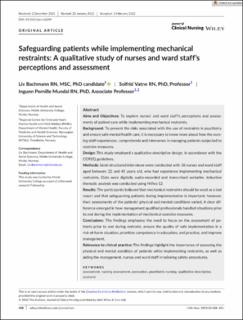| dc.contributor.author | Bachmann, Liv | |
| dc.contributor.author | Vatne, Solfrid | |
| dc.contributor.author | Mundal, Ingunn Pernille | |
| dc.date.accessioned | 2023-04-13T13:25:07Z | |
| dc.date.available | 2023-04-13T13:25:07Z | |
| dc.date.created | 2022-02-21T09:31:13Z | |
| dc.date.issued | 2022 | |
| dc.identifier.citation | Journal of Clinical Nursing (JCN). 2022, 32 (3/4), 438-451. | en_US |
| dc.identifier.issn | 0962-1067 | |
| dc.identifier.uri | https://hdl.handle.net/11250/3062933 | |
| dc.description.abstract | Aims and Objectives: To explore nurses’ and ward staff's perceptions and assessments of patient care while implementing mechanical restraints. Background: To prevent the risks associated with the use of restraints in psychiatry and ensure safe mental health care, it is necessary to know more about how the nursing staff experiences, comprehends and intervenes in managing patients subjected to coercive measures. Design: This study employed a qualitative descriptive design, in accordance with the COREQ guidelines. Methods: Semi-structured interviews were conducted with 18 nurses and ward staff aged between 22 and 45 years old, who had experience implementing mechanical restraints. Data were digitally audio-recorded and transcribed verbatim. Inductive thematic analysis was conducted using NVivo 12. Results: The participants believed that mechanical restraints should be used as a last resort and that safeguarding patients during implementation is important; however, their assessments of the patients’ physical and mental conditions varied. A clear difference emerged in how management qualified professionals handled situations prior to and during the implementation of mechanical coercive measures. Conclusions: The findings emphasise the need to focus on the assessment of patients prior to and during restraint, ensure the quality of safe implementation in a risk-of-harm situation, prioritise competence in education, and practice, and improve management. Relevance to clinical practice: The findings highlight the importance of assessing the physical and mental condition of patients while implementing restraints, as well as aiding the management, nurses and ward staff in tailoring safety procedures. | en_US |
| dc.description.abstract | Safeguarding patients while implementing mechanical restraints : a qualitative study of nurses and ward staff’s perceptions and assessment | en_US |
| dc.language.iso | eng | en_US |
| dc.publisher | Wiley | en_US |
| dc.relation.uri | https://doi.org/10.1111/jocn.16249 | |
| dc.rights | Navngivelse 4.0 Internasjonal | * |
| dc.rights.uri | http://creativecommons.org/licenses/by/4.0/deed.no | * |
| dc.title | Safeguarding patients while implementing mechanical restraints : a qualitative study of nurses and ward staff’s perceptions and assessment | en_US |
| dc.title.alternative | Safeguarding patients while implementing mechanical restraints : a qualitative study of nurses and ward staff’s perceptions and assessment | en_US |
| dc.type | Peer reviewed | en_US |
| dc.type | Journal article | en_US |
| dc.description.version | publishedVersion | en_US |
| dc.source.pagenumber | 438-451 | en_US |
| dc.source.volume | 32 | en_US |
| dc.source.journal | Journal of Clinical Nursing (JCN) | en_US |
| dc.source.issue | 3/4 | en_US |
| dc.identifier.doi | 10.1111/jocn.16249 | |
| dc.identifier.cristin | 2003909 | |
| cristin.ispublished | true | |
| cristin.fulltext | original | |
| cristin.qualitycode | 2 | |

